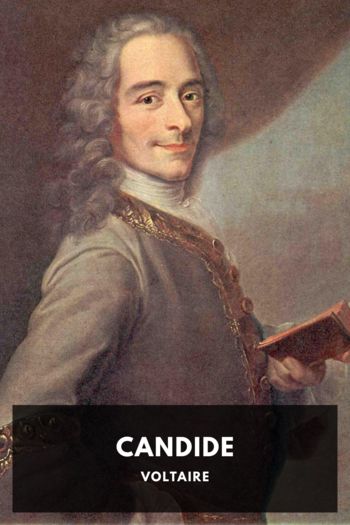Candide Voltaire (inspirational books for students .TXT) 📖

- Author: Voltaire
Book online «Candide Voltaire (inspirational books for students .TXT) 📖». Author Voltaire
“This Notre-Dame is of wood; every year she weeps on the day of her fête, and the people weep also. One day the preacher, seeing a carpenter with dry eyes, asked him how it was that he did not dissolve in tears when the Holy Virgin wept. ‘Ah, my reverend father,’ replied he, ‘it is I who refastened her in her niche yesterday. I drove three great nails through her behind; it is then she would have wept if she had been able.’ ”
—Voltaire, Mélanges.↩
The following posthumous note of Voltaire’s was first added to M. Beuchot’s edition of his works issued in 1829: “See the extreme discretion of the author; there has not been up to the present any Pope named Urban X; he feared to give a bastard to a known Pope. What circumspection! What delicacy of conscience!” The last Pope Urban was the eighth, and he died in 1644. ↩
Muley-Ismael was Emperor of Morocco from 1672 to 1727, and was a notoriously cruel tyrant. ↩
“Oh, what a misfortune to be an eunuch!” ↩
Carlo Broschi, called Farinelli, an Italian singer, born at Naples in 1705, without being exactly Minister, governed Spain under Ferdinand VI; he died in 1782. He has been made one of the chief persons in one of the comic operas of MM. Auber and Scribe. ↩
Jean Robeck, a Swede, who was born in 1672, will be found mentioned in Rousseau’s Nouvelle Héloïse. He drowned himself in the Weser at Bremen in 1729, and was the author of a Latin treatise on voluntary death, first printed in 1735. ↩
A spontoon was a kind of half-pike, a military weapon carried by officers of infantry and used as a medium for signalling orders to the regiment. ↩
Later Voltaire substituted the name of the Father Croust for that of Didrie. Of Croust he said in the Dictionnaire Philosophique that he was “the most brutal of the Society.” ↩
By the Journal of Trevoux Voltaire meant a critical periodical printed by the Jesuits at Trevoux under the title of Mémoires pour servir à l’Historie des Sciences et des Beaux-Arts. It existed from 1701 until 1767, during which period its title underwent many changes. ↩
It has been suggested that Voltaire, in speaking of red sheep, referred to the llama, a South American ruminant allied to the camel. These animals are sometimes of a reddish colour, and were notable as pack-carriers and for their fleetness. ↩
The first English translator curiously gives “a tourene of bouilli that weighed two hundred pounds,” as the equivalent of “un contour bouilli qui pesait deux cent livres.” The French editor of the 1869 reprint points out that the South American vulture, or condor, is meant; the name of this bird, it may be added, is taken from cuntur, that given it by the aborigines. ↩
Spanish half-crowns. ↩
Socinians; followers of the teaching of Lalius and Faustus Socinus (16th century), which denied the doctrine of the Trinity, the deity of Christ, the personality of the devil, the native and total depravity of man, the vicarious atonement and eternal punishment. The Socinians are now represented by the Unitarians. Manicheans; followers of Manes or Manichæus (3rd century), a Persian who maintained that there are two principles, the one good and the other evil, each equally powerful in the government of the world. ↩
In the 1759 editions, in place of the long passage in brackets from here to page 215, there was only the following: “ ‘Sir,’ said the Perigordian Abbé to him, ‘have you noticed that young person who has so roguish a face and so fine a figure? You may have her for ten thousand francs a month, and fifty thousand crowns in diamonds.’ ‘I have only a day or two to give her,’ answered Candide, ‘because I have a rendezvous at Venice.’ In the evening after supper the insinuating Perigordian redoubled his politeness and attentions.” ↩
The play referred to is supposed to be Le Comte d’Essex, by Thomas Corneille. ↩
In France actors were at one time looked upon as excommunicated persons, not worthy of burial in holy ground or with Christian rites. In 1730 the “honours of sepulture” were refused to Mademoiselle Lecouvreur (doubtless the Miss Monime of this passage). Voltaire’s miscellaneous works contain a paper on the matter. ↩
Élie-Catherine Fréron was a French critic (1719–1776) who incurred the enmity of Voltaire. In 1752 Fréron, in Lettres sur quelques écrits du temps, wrote pointedly of Voltaire as one who chose to be all things to all men, and Voltaire retaliated by references such as these in Candide. ↩
Gabriel Gauchat (1709–1779), French ecclesiastical writer, was author of a number of works on religious subjects. ↩
Nicholas Charles Joseph Trublet (1697–1770) was a French writer whose criticism of Voltaire was revenged in passages such as this one in Candide, and one in the Pauvre Diable beginning:
L’abbé Trublet avait alors le rage
D’être à Paris un petit personage.
↩
Damiens, who attempted the life of Louis XV in 1757, was born at Arras, capital of Artois (Atrébatie). ↩
On May 14, 1610, Ravaillac assassinated Henry VI. ↩
On December 27, 1594, Jean Châtel attempted to assassinate





Comments (0)